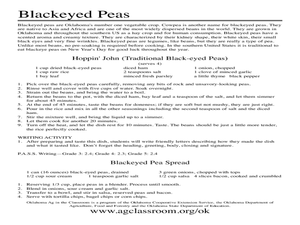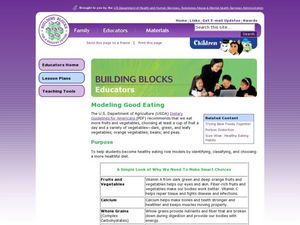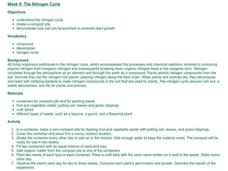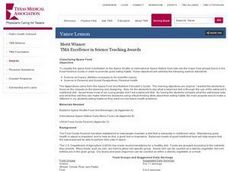Curated OER
Eat A Rainbow!
Students demonstrate the importance of eating fruits and vegetables. In this nutrition instructional activity, students identify and sort different fruits and vegetables by colors. Students list reasons why eating fruits and vegetables...
Curated OER
THE PEANUT WIZARD
Students read information about George Washington Carver and outline the information. They are given peanuts in the shell, students examine them and eat them. Students discuss the following questions: Why did George Washington Carver...
Curated OER
The Effects of the Calcium Ion on Cooked Dry Beans
Students investigate the effects of calcium ions on the quality characteristics of cooked dry beans. In this calcium ion and dry bean investigation lesson plan, students soak dry beans using 2 different soaking techniques and 2 different...
Curated OER
Blackeyed Peas
Young scholars examine the history of black-eyed peas. In this black-eyed peas lesson, students read about the history of the peas/beans and about how they are Oklahoma's number one vegetable crop. They also read that they are considered...
Curated OER
PICKING PEANUTS
Students create sentences, using words printed on pictures of peanuts. They are explained that the peanut is not really a nut, but a legume, related to beans and peas. Students are also told that the first peanuts grew in Brazil. They...
Curated OER
Fit With Fiber
Sixth graders investigate the nutritional value of different types of cereal. They take a survey of students that ate breakfast and create a circle graph with the results. Students examine the nutritional information on the sides of the...
Curated OER
Modeling Good Eating
Students identify and classify the items in a healthy diet. In this dietary lesson, students listen to a song about healthy eating while listening for good snack foods. They use pictures of the snacks to complete a large chart by...
Curated OER
The Disappearing Honeybees: Tracking Honeybee Decline
Students practice graphing and other math skills to track number of honeybee colonies present in United States since 1978, discuss major crops that are dependent on insect pollinators, and examine reasons for decline of United States...
Curated OER
Food - What's in It for You?
Students examine healthy eating and nutrition. They read and discuss articles, and create a list of ten healthy eating tips in the form of a poster, newspaper article, or presentation.
Curated OER
The Nitrogen Cycle
Pupils design and create a compost pile in order to study the Nitrogen Cycle. They then use the scientific method to determine if plants grow better when they add organic matter from their compost pile to the plant's soil.
Curated OER
Matching Flowers With Their Pollinators
Young scholars match flowers to pollinators and construct models of
flowers to demonstrate why different kinds of flowers need different kinds of
pollinators. They use their flower models and the "Scientific Method Format" included in...
Curated OER
Phytochemicals
Students study what phytochemicals are, how they work and where you can find them. In this food chemicals lesson students complete and activity and study products that contain phytochemicals.
Curated OER
Eating for Your Future
Students brainstorm ways to live healthy. In this health science lesson, students recipes that are healthy and appealing. They compile all recipes and develop a class cookbook.
Curated OER
Training Table Race
Students investigate the role of the carbohydrates food group in sports performance. The difference between simple and complex carbohydrates, and the performance of cardiovascular activities form the focus of the lesson.
Curated OER
Classifying Space Food
Students write a written summary of what they have learned about the astronaut nutritional diet in comparison with their own diet habits.
















